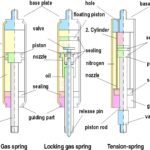Technology | Gas Spring | History | Forces | Nitrogen & Oil | Instructions | Disposal
Nitrogen & Oil in Gas Springs
A standard Gas Spring is filled with about 80% pure nitrogen and 20% oil.
Nitrogen is an inert gas, it does not burn, it does not explode and it is not toxic.

But gas springs have a very high internal pressure. Under no circumstances may they be opened without taking our disposal regulations into account!
Gas springs can be used by
-300C to + 800C (nominal 20 ° C). For other temperature ranges
(down to -55 ° C or up to + 200 ° C)
special sealing kits are available.
A change in the force of the spring must be expected for applications that deviate significantly from the nominal temperature.
The extension force increases or decreases at 3.4% per 10 ºC.
Graphic temperature influence
The oil in the gas spring has a triple effect:
1. Lubrication of the piston rod.
2. Lubrication of the seal.
3. Attenuation.
Gas springs should always be installed with the piston rod facing downwards so that the sealing package or the piston rod has permanent lubrication. This position guarantees the best damping properties.
When installed correctly so that the piston rod points downwards and properly maintained, the gas springs have a very long service life.
In principle, warranty claims expire at the latest one year after the date of manufacture. Manufacturing defects or quality defects can be identified immediately.
